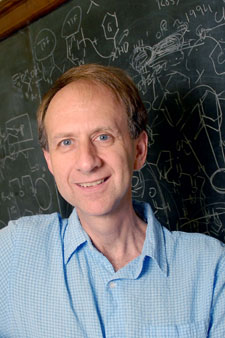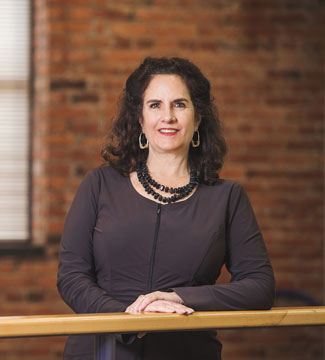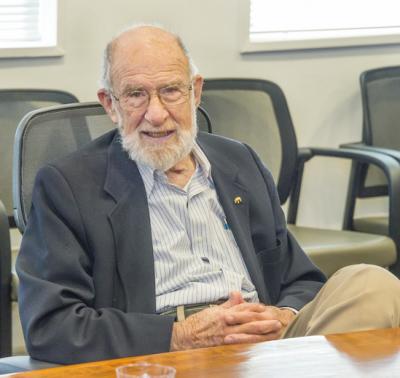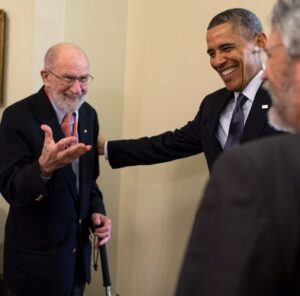Cancer Fighter
Professor’s personal battle leads to development of new cancer drug
Jonathan Sessler wanted to ignore the pain. After all, his senior year at the University of California at Berkeley gave him plenty of things to take his mind off the persistent aching he felt under his arm. There were exams to study for, chemistry labs to finish and grad school applications to worry about. But Sessler’s older brother Dan, a first-year medical student at the time, would have none of his younger brother’s hemming and hawing and hassled him to get checked out by a doctor.
Sessler finally relented, and a week later he found himself in the hospital minus a spleen and having his upper body blasted with an aggressive radiation treatment for Hodgkin’s lymphoma, a cancer of the lymph system. He’s now thankful for his brother’s insistence. The treatment worked and the cancer went into remission.
Despite the overwhelming stress of cancer treatment and school, Sessler graduated in 1977 with honors in chemistry and began pursuing his doctor’s degree at Stanford University. Then, one frightening day in his third year, Sessler heard something no cancer survivor ever wants to hear: his lymphoma was back.
This time, Sessler received chemotherapy under the care of a young attending physician at Stanford named Dr. Richard A. Miller. Against all odds, he beat his cancer a second time and returned to his research with a challenge issued by Miller that would loop through his brain for years to come.
“You’re a chemist,” said Miller in 1979. “Find new cancer drugs.”
More than 25 years later, Sessler and Miller, co-founders of the company Pharmacyclics, Inc., are riding high on the news of the latest trials of the drug Xcytrin®, based on molecules developed in Sessler’s lab. The drug has shown promise in delaying some symptoms associated with brain cancer that has spread from the lungs. The results are promising enough that Pharmacyclics plans to file a New Drug Application with the U.S. Food and Drug Administration (FDA) this year.
Developing a cancer-fighting molecule
When Sessler arrived in the Department of Chemistry and Biochemistry in 1984, he hadn’t yet found an answer to Miller’s charge.
“As much as I wracked my brains, I just couldn’t figure out a way to make that new cancer drug,” says Sessler, now the Roland K. Petitt Centennial Professor of Chemistry and Biochemistry at The University of Texas at Austin. He’d been studying porphyrins, the highly pigmented molecules that help make up the hemoglobin in red blood cells.
 “But when I arrived in Texas, it became clear that here, everything is bigger,” he jokes. “So I had this simple idea to make a bigger version of porphyrins.”
“But when I arrived in Texas, it became clear that here, everything is bigger,” he jokes. “So I had this simple idea to make a bigger version of porphyrins.”
Porphyrins, Sessler knew, concentrate in cancer cells. If he could make one of these molecules large enough to hold a heavy metal like gadolinium, which is commonly used to produce magnetic resonance imaging (MRI) agents, the new molecule could be used to enhance MRIs and in the treatment of cancer.
The young, affable Sessler surrounded himself with extremely talented graduate students such as Greg Hemmi, Tarak Mody and Darren Magda, a postdoctoral fellow named Dr. Toshiaki Murai, and kept working hard. After about five years, he got what he was looking for: a larger porphyrin molecule that can hold a heavy metal at its center. One afternoon during a lab meeting at the Crown & Anchor Pub, the Sessler Lab dubbed the new Texas-sized molecules “texaphyrins.”
From lab bench to bedside
When Miller learned of the new texaphyrins during Sessler’s annual check-up in California in the late 1980s, he immediately suggested they start a company. And that, according to Sessler, is when the hard work began.
“Teaching and research is pure joy,” he says. “The only thing that’s really hard is fundraising.”
Luckily, Miller had a knack for the business, and by 1991, Pharmacyclics, Inc. was born.
Pharmacyclics, in Sunnyvale, Calif., licensed the technology behind texaphyrins from the university and has been developing commercial and medical uses for the molecules. Miller has served as president and CEO of the company since its inception and Sessler’s former students, Hemmi, Mody and Magda, migrated there to work as research scientists.
 Without Miller, Sessler is quick to point out that he wouldn’t be here today nor would his science have moved as far as it has into the world of medicine.
Without Miller, Sessler is quick to point out that he wouldn’t be here today nor would his science have moved as far as it has into the world of medicine.
“Dr. Miller knows what is and is not important medically,” he says. “We’re the chemists. Without the creative spark between the two, there’s no chance.”
It’s this interplay between medical doctors and scientists that the new Texas Institute for Drug and Diagnostic Development (TI-3D), of which Sessler is a founding member, aims to foster. TI-3D promises to help academic scientists at the university navigate through some of the complicated issues surrounding moving a new molecule or medical diagnostic technique into the medical stream.
Though Sessler didn’t have an organization like TI-3D to help, he holds up Pharmacyclics and the recent successes of Xcytrin as an example of what can happen when academic scientists, entrepreneurs and medical doctors work together.
Fighting cancer with Xcytrin
In recent Phase 3 trials, Pharmacyclics and its collaborators delivered the texaphyrin-based drug Xcytrin (motexafin gadolinium) in conjunction with whole brain radiation treatment to more than 500 patients with non-small cell lung cancer that had spread to the brain. When such cancers begin taking over important centers of function in the brain, people begin to experience changes in muscle strength, vision and mental state, a process called neurologic progression.
In North America, patients receiving Xcytrin plus radiation experienced neurologic progression 16 months later than patients not receiving the treatment. The company announced these promising results at the annual meeting of the American Society of Clinical Oncology in June 2006.
 Sessler says texaphyrins like those used in Xcytrin focus on cancer cells and disrupt cellular metabolism and energy production, weakening or destroying the cells.
Sessler says texaphyrins like those used in Xcytrin focus on cancer cells and disrupt cellular metabolism and energy production, weakening or destroying the cells.
“In conjunction with radiation, Xcytrin enhances cancer cell death,” says Sessler. “Radiation puts stress on the cells and the drug puts further stress on the cells. Add them together and the cells start to die.”
Texaphyrins steal electrons from cell-protecting molecules (for example, antioxidants) and produce compounds toxic to cells, like peroxide.
“Texaphyrins steal away the things that could protect a cell and as a result they make more of the very things the cell is trying to protect against,” Sessler explains. “Now this sounds terrible, except that texaphyrins are highly localized in cancer. So you’re going to kill cancer cells. This is devilishly clever.”
And texaphyrins are relatively non-toxic to normal cells, which is a great boon when talking about harsh cancer treatments. Other trials are now underway to test the potential of Xcytrin to act as a stand-alone chemotherapeutic agent or in combination with other known cancer drugs.
By helping develop a new cancer drug that has extended the quality of life of real patients battling a terrible disease, Sessler is closer than he’s ever been to meeting Miller’s challenge. He’s hopeful that the FDA will approve the drug for treating cancer patients.
“I don’t think it’s fair to cancer patients to have to wait through another five years of trials,” he says. “I’m hoping that this will receive a fair hearing at the FDA, and they come to the conclusion that the benefits to patients outweigh any concern.”
BY Lee Clippard
Photo of Dr. Sessler: Matt Lankes





